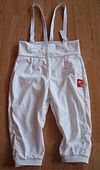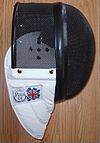- Fencing
-
This article is about the sport, which is distinguished from stage fencing, academic fencing (mensur), historical fencing, SCA fencing, and swordsmanship. For the boundary structure, see Fence. For other uses, see Fencing (disambiguation).
Fencing 
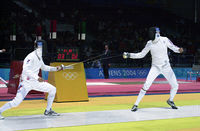
Russian Igor Tourchine and American Weston "Seth" Kelsey fence in the second round of the Men's Individual Épée event in the 2004 Summer Olympics at the Helliniko Fencing Hall on August 17, 2004Focus Weaponry Olympic sport 1896-present Official website www.fie.ch Fencing, which is also known as modern fencing to distinguish it from historical fencing,[1] is a family of combat sports using bladed weapons.
Fencing is one of four sports which have been featured at every one of the modern Olympic Games. The sport of fencing is divided into three weapons:
- Foil—a light thrusting weapon that targets the torso, including the back, but not the arms. Touches are scored only with the tip; hits with the side of the blade do not count, and do not halt the action. Touches that land outside of the target area (off-target) stop the action, and are not scored. Only a single hit can be scored by either fencer at one time. If both fencers hit at the same time, the referee uses the rules of right of way to determine which fencer gets the point.
- Sabre—a light cutting and thrusting weapon that targets the entire body above the waist, excluding the hands. Hits with the edges of the blade as well as the tip are valid. As in foil, touches which land outside of the target area are not scored. However, unlike foil, these off-target touches do not stop the action, and the fencing continues. In the case of both fencers landing a scoring touch, the referee determines which fencer receives the point for the action.
- Épée—a heavier thrusting weapon that targets the entire body. All hits must be with the tip and not the sides of the blade. Touches hit by the side of the blade do not halt the action. Unlike foil and sabre, Épée does not use right of way, and allows simultaneous hits by both fencers. However, if the score is tied at the last point and a double touch is scored, nobody is awarded the point.
Contents
History
Modern fencing originated in the 18th century, as a direct continuation of the 18th century French school of fencing which had in turn been influenced by the Italian school of the Renaissance.[2][3]
Further information: History of martial artsTerminology
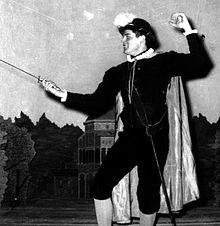 Shakespearean actor in fencing stance
Shakespearean actor in fencing stance Main article: Glossary on fencing
Main article: Glossary on fencingThe English term fencing, in the sense of "the action or art of using the sword scientifically" (OED) dates to the late 16th century, when it denoted systems designed for the Renaissance rapier. The first known use of defens in reference to Renaissance swordsmanship is in William Shakespeare's Merry Wives of Windsor: "Alas sir, I cannot fence."[4] This specialized usage replaced the generic fight (Old English feohtan).
The verb to fence derived from the noun fence, originally meaning "the act of defending", etymologically derived from Old French defens "defence", ultimately from the Latin. The first attestation of Middle English fens "defence" dates to the 14th century.[5]
Antiquity
The origins of armed combat are prehistoric, beginning with club, spear and axe. Fighting with shield and sword developed in the Bronze Age; Bladed weapons such as the khopesh appeared in the Middle Bronze Age, and the proper sword in the Late Bronze Age.
Homer's Iliad includes some of the earliest descriptions of combat with shield, sword and spear, usually between two heroes who pick one another for a duel. Roman gladiators engaged in dual combat in a sport-like setting, evolving out of Etruscan ritual. Tomb frescoes from Paestum (4th century BC) show paired fighters, with helmets, spears and shields, in a propitiatory funeral blood rite that anticipates gladiator games.[6]
Romans who frequented the gymnasia and baths often fenced with a stick whose point was covered with a ball. Vegetius, the Late Roman military writer described practicing against a post and fencing with other soldiers. Vegetius describes how the Romans preferred the thrust over the cut, because puncture wounds enter the vital organs directly whereas cuts are often stopped by armour and bone. Raising the arm to deliver a cut exposes the side to a thrust.[7] This doctrine was exploited by Italian fencing masters in the 16th Century and became the primary rationale behind both the Italian and French schools of fencing.[citation needed]
Middle Ages and Renaissance
Main articles: Historical European Martial Arts and Dardi schoolFencing schools can be found in European historical records dating back to the 12th century. In later times fencing teachers were paid by rich patrons to produce books about their fighting systems, called treatises. Fencing schools were forbidden in some European cities (particularly in England and France) during the medieval period, though court records show that such schools operated illegally.[citation needed]
The earliest surviving treatise on fencing, stored at the Royal Armouries Museum in Leeds, England, dates from around 1300 AD and is from Germany. It is known as I.33 and written in medieval Latin and Middle High German and deals with an advanced system of using the sword and buckler (smallest shield) together.
From 1400 onwards an increasing number of fencing treatises survived from across Europe, with the majority from the 15th century coming from Germany and Italy. In this period these arts were largely reserved for the knighthood and the nobility – hence most treatises deal with knightly weapons, such as the rondel dagger, longsword, spear, pollaxe and armoured fighting mounted and on foot. Some treatises cover weapons available to the common classes, such as großes Messer and sword and buckler. Wrestling, both with and without weapons, armoured and unarmoured, was also featured heavily in the early fencing treatises.
By the 16th century, with the widespread adoption of the printing press, the increase in the urban population and other social changes, the number of treatises increased dramatically. After around 1500 carrying swords became more acceptable in most parts of Europe. The growing middle classes meant that more men could afford to carry swords, learn fencing and be seen as gentlemen. By the middle of the 16th century many European cities contained great numbers of fencing schools, often clustered together, such as in London at "Hanging Sword Lane". Italian fencing masters were particularly popular and set up schools in many foreign cities. The Italians brought concepts of science to the art, appealing to the Renaissance mindset.[8]
In 16th century Germany compendia of older Fechtbücher techniques were produced, some of them printed, notably by Paulus Hector Mair (in the 1540s) and by Joachim Meyer (in the 1570s), based on 14th century teachings of the Liechtenauer tradition. In this period German fencing developed sportive tendencies.
The rapier's popularity peaked in the 16th and 17th centuries. The Dardi school of the 1530s, as exemplified by Achille Marozzo, still taught the two-handed spadone, but preferred the single–handed sword. The success of Italian masters such as Marozzo and Fabris outside of Italy shaped a new European mainstream of fencing.
The Ecole Française d’Escrime founded in 1567 under Charles IX produced masters such as Henry de Sainct-Didier who introduced the French fencing terminology that remains in use today.[9]
Early modern period
Further information: French school of fencing, Rapier fencing, Destreza, and Joseph SwetnamStrictly, the European dueling sword is a basket and cage hilted weapon specifically used in duels from the late 17th to the 19th century. It developed through several forms of the rapier to the smallsword—reflecting the changes from a cutting style of swordplay to a thrusting style ('foining'). This was a result of increasing specialization in their use on the dueling field, and the social stigma attached to carrying and using swords too obviously adapted to the actual "work" of warfare. The smallsword, and the last version of the rapier, were made possible only by metallurgical advances in the 17th century as high toughness steels became more readily available.[citation needed]
In England, it was not uncommon for fencing masters to duel other masters, often to the death, stopping to dress wounds. Such spectacles were generally held in beargardens, particularly in the Southwark neighborhood near London.[10]
The foil was invented in France as a training technique in the middle of the 18th century; it enabled fast and elegant thrust fencing with a smaller and safer weapon than a dueling sword. Fencers blunted (or "foiled") its point by wrapping a foil around the blade or fastening a knob on the point ("blossom", French fleuret). Some fencers took away the protection and used the sharp foil for duels. German students took up that practice and developed the Pariser ("Parisian") thrusting small sword for the Stoßmensur ("thrusting mensur").
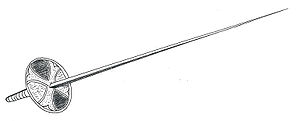 "Pariser" small sword, derived from the French foil
"Pariser" small sword, derived from the French foil
After the dress sword was abolished, the Pariser became the only weapon for thrust fencing in German colleges and universities. Many students died from pierced lungs (Lungenfuchser). A countering movement started in Göttingen in the 1750s, with the invention of the Göttinger Hieber, a predecessor of the modern Korbschläger, a weapon for cut fencing. In the following years, the Glockenschläger was invented in an Eastern Germany university, also for cut fencing.[11]
1800 to 1918
Further information: Classical fencing and Academic fencingThrust fencing (using the Pariser), and cut fencing (using Korbschläger or Glockenschläger), existed in parallel in Germany during the first decades of the 19th century, according to local preferences. Thrust fencing was especially popular in Jena, Erlangen, Würzburg and Ingolstadt/Landshut, two towns where the predecessors of Munich University were located. The last thrust Mensur is recorded to have taken place in Würzburg in 1860.
Until the first half of the 19th century all types of academic fencing can be seen as duels, since fencing with sharp weapons was about honour. No combat with sharp blades took place without a formal insult. For duels involving non-students, e.g. military officers, the academic sabre became usual, apparently derived from the military sabre. It was then a heavy weapon with a curved blade and a hilt similar to the Korbschläger.
Classical fencing derives most directly from the 19th and early–20th century national fencing schools, especially in Italy and France, although other pre–World War II styles such as Russian and Hungarian are also considered classical[citation needed]. Masters and legendary fencing figures such as Giuseppe Radaelli, Louis Rondelle, Masaniello Parise, the Greco brothers, Aldo Nadi and his rival Lucien Gaudin were typical practitioners of this period.
Fencing was part of the first Olympics Games in the summer of 1896. Épée and Sabre events have been held at every Summer Olympics; foil events have been held at every Summer Olympics except 1908.
Four judges determined whether a touch had been made. Two side judges stood behind and beside each fencer, watching for hits made by that fencer. A director observed from several feet away. At the end of each action, after calling "Halt!", the director described the action, and then polled the judges. If the judges differed, or abstained, the director could overrule. However, while the director had 1 1/2 votes, and the judges only 1 each, 2 judges in agreement could overrule the director.
This method had serious limitations, though it was universally used. As described in the London newspaper, the Daily Telegraph & Courier, on June 25, 1896: "Every one who has watched a bout with the foils knows that the task of judging the hits is with a pair of amateurs difficult enough, and with a well-matched pair of maîtres d’escrime well–nigh impossible." There also were problems with bias: well–known fencers were often given the benefit of mistakes (so–called "reputation touches"), and in some cases there was outright cheating. Aldo Nadi complained about this in his autobiography The Living Sword in regard to his famous match with Lucien Gaudin. The Daily Courier article described a new invention, the electrical scoring machine, that would revolutionize fencing.
1918 to present
Dueling went into sharp decline after World War I. After World War II, dueling went out of use in Europe except for very rare exceptions. Training for duels, once fashionable for males of aristocratic backgrounds (although fencing masters such as Hope suggest that many people considered themselves trained from taking only one or two lessons), all but disappeared, along with the classes themselves. Fencing continued as a sport, with tournaments and championships. However, the need to actually prepare for a duel with "sharps" vanished, changing both training and technique.
Starting with épée in 1936, side judges were replaced by an electrical scoring apparatus,[12] with an audible tone and a red or green light indicating when a touch landed. Foil was automated in 1956, sabre in 1988. The scoring box reduced the bias in judging, and permitted more accurate scoring of faster actions, lighter touches, and more touches to the back and flank than before.[citation needed]
Forms of fencing
Olympic Fencing
Olympic fencing refers to the fencing seen in most current competitions, including the Olympic Games and the World Cup. Competitions are conducted according to rules laid down by the Fédération Internationale d'Escrime (FIE), the international governing body. These rules evolved from a set of conventions developed in Europe between mid-17th and early 20th century. The three Olympic weapons are foil, épée, and sabre. In competition, the validity of touches is determined by the electronic scoring apparatus and a set of rules called right of way or priority to eliminate referee error and bias.
In the United States
In the United States, athletes compete at local and national levels, for the most part sanctioned by the United States Fencing Association (USFA). Locally, athletes register for tournaments in their division via a website called "Askfred.net."[13] Nationally, athletes compete in tournaments called North American Cups, or NACs for short,[14] as well as championship events including the Junior Olympics and Summer National Championships. At these tournaments, competitors are divided by sex, weapon, age group, and division (skill level). Age groups include Y10 (Youth 10, or 10 and younger) Y12 (12 and younger), Y14 (14 and younger), Cadet (under 17), Junior (under 20), as well as a variety of Veterans' categories for fencers over 40, 50, 60, or 70.
National ratings are awarded by the USFA and range from A through E (A being the highest and E the lowest), with U for all unrated fencers. Ratings are awarded based on number of competitors in a tournament and the strength of the tournament. Some competitions require competitors to meet the rating criteria. Division I fencing requires ratings of C or higher; Division II requires ratings of C or lower; Division III requires D or lower. A national points system for the age groups as well as Division 1 is based on results at national events and determines qualification for World Championships, World Cups, and the Olympics.
In the most common tournament format, fencers first fence 5 to 7 others (a round-robin "pool") in 5-touch bouts. The fencers are then seeded against all other competing fencers based on their pool results. A certain percentage of the lowest-seeded fencers (typically 20-25%) is sometimes cut from the competition prior to the direct elimination bracket. Fencers are then placed into a bracket based on the seeding and fence single-elimination bouts, usually to 15 touches. The winners advance in the bracket, and the losers are eliminated from the tournament.
Wheelchair Fencing
Wheelchair fencing, an original Paralympic sport, was developed in post-World War II England. Minor modifications to the FIE rules allow disabled fencers to fence all three weapons. The most apparent change is that each fencer sits in a wheelchair fastened to a frame. Footwork is replaced by torso or arm movement, depending on the fencer's disability. The proximity of the two fencers tends to increase the pace of bouts. The fencers use standard Olympic weapons.
Other variants
Other variants include one-hit épée (one of the five events which constitute modern pentathlon) and the various types of non-Olympic competitive fencing. One example of the latter is the American Fencing League (distinct from the United States Fencing Association): the format of competitions is different and the right of way rules are interpreted in a different way. In a number of countries, school and university matches deviate slightly from the FIE format.
Weapons
Three weapons survive in modern competitive fencing: foil, épée, and sabre. The spadroon and the heavy cavalry-style sabre, both popular in the 19th century, fell into disfavour in the early 20th century, replaced by lighter and faster weapons. The singlestick was featured in the 1904 Olympic Games, but it was already declining in popularity. Bayonet fencing experienced a somewhat slower decline, with competitions organized by some armed forces as late as the 1940s and 1950s.
While the weapons differ in shape and use, their basic construction is similar across the disciplines. Every weapon has a blade and a hilt. The tip of the blade is generally referred to as the point, the top third of the blade as the flexible foible (weak in French), while the base of the blade is referred to as "the forté" (or strong part). The hilt consists of a guard and a grip. The guard (also known as the coquille, the bell, or the bellguard) is a metal shell designed to protect the fingers. The grip is the weapon's handle. In foil and épée the more traditional French grip is approximately straight and usually terminates with a pommel (a heavy nut intended to act as a counterweight for the blade and to hold the handle on the weapon). Some modern French grip designs do not use a heavy pommel nut, in an effort to reduce weight.
The Italian grip, dating from a similar period, has fallen out of general favor. It features a straight handle and a crossbar beneath the guard that the fencer can use to manipulate the blade. The crossbar is known for causing injury, as the fencer's fingers can become stuck if the blade is turned unexpectedly. It is the only ambidextrous fencing grip, and many fencers with arm trouble use it so they can freely switch without having to carry twice as many blades. The Italian is banned in some regions, and is mistakenly believed to be banned in others, necessitating that users often carry explicit rulings to show judges to prove it is allowed.
French grips have been entirely replaced in higher level foil fencing, and partially replaced in épée fencing, by ergonomic designs, called pistol grips or orthopaedic grips. Among the many designs, the most popular are the Visconti, Belgian, and Russian grips. Grips produced by Zivkovic fencing are also popular, and are the most commonly seen 'non-standard' grips.
Modern competitive weapons have electrical wiring which allows them to register a touch on the opponent via an electrical scoring system.
Foil
Main article: Foil (fencing)Short clip of foil fencing
The foil is light and flexible, originally developed in the mid-17th century as a training weapon for the Pariser small sword, a light one-handed sword designed almost exclusively for thrusting.
Electric foils have a push-button on the point of the blade, which allows hits to be registered by an electronic scoring apparatus. In order to register, the button must be depressed with a force of at least 4.90 newtons (500 grams-force) for at least 15 milliseconds. Foil and Sabre fencers wear conductive jackets (lamé) covering their target area, which allow the scoring apparatus to differentiate between on- and off-target hits.
The target area is restricted to the torso, including the front and back. A modification in FIE rules from 1 January 2009 includes as valid target area the part of the mask's bib below a straight line drawn between the shoulders; prior to this, the bib of the fencer's mask was not a valid target. International events such as Junior or Senior World Cup Events require the bib target. However, this rule has not been implemented uniformly in all National fencing organizations. European fencing organizations generally decided on September 1, 2009 as the date for all competitions to use the new rule.[citation needed]
Foil fencing is conducted using rules of right of way. The basic principle is that, if both fencers score a touch on the other, the fencer who began their offensive action first prevails, unless that offensive action fails. A fencer's action fails if it misses his/her opponent, or it is parried. If priority cannot be determined when both fencers have hit each other, no point is awarded.
The original idea behind the rules of foil fencing was to encourage fencers to defend and attack vital areas, and to fight in a methodical way with initiative passing back and forth between the combatants, thus minimizing the risk of a double death.
The target must be hit with the tip of the foil; a touch with any other part of the foil has no effect whatsoever and fencing continues uninterrupted. A touch on an off-target area halts the action, but does not score a point.
When an exchange ends in a hit, the referee will call "halt," and fencing will cease. The referee will then analyze the exchange and phrase it in official terminology. An example of this terminology would be "Attack from the left, no. Parry-Riposte from the right is good. Touch right."
The first offensive action is called the attack. All defensive actions successfully deflecting an opponent's blade are called parries. An offensive action of a parrying fencer directly following the parry is called a riposte. An offensive action of a fencer, who attacks a second time without first withdrawing the arm after an unsuccessful first attack, is called a remise. An offensive action of a fencer from the on-guard position, after being parried and then returning to the on-guard position, is called a reprise. An offensive action of a fencer after his/her opponent has lost the right to riposte via inaction is called a redouble. An offensive action begun by a fencer who is being attacked by his/her opponent is called a counter-attack.
Épée
Main article: ÉpéeShort clip of épée fencing
The modern sporting Épée was invented in the second half of the 19th century by a group of French students, who felt that the conventions of foil were too restrictive, and the weapon itself too light; they wanted an experience closer to that of an actual duel. The concept was to create an exact copy of a small sword but without the needle-sharp point. Instead, the blade terminated in a point d'arrêt, a three-pronged tip which would snag on the clothing without penetrating the flesh.
The épée is a thrusting weapon: to score a valid hit, the fencer must fix the point of his weapon on his opponent's target. The épée target area is the entire body. No rules control the timing of hits. When fencing electronically, fencers do not wear conductive lamé jackets as they do when fencing foil and sabre. In the event of both fencers making a touch within 40 milliseconds of each other, both are awarded a point (a double hit). When the score is equal and the point would mean the win for both, such as in modern pentathlon's one-hit épée, neither receives a point. Otherwise, the first to hit always receives the point, regardless of what happened earlier in the phase. The épée is the typically heaviest of the sporting weapons, although some épée blades weigh only 150 grams (5.3 oz). An épée is composed of a blade, a point, a bell guard, and a handle or grip (French or pistol grip).
The electric épée, used in modern competitive fencing, terminates in a push-button. A hit must arrive with a force of at least 7.35 newtons (1.65 lbf) and the push-button must remain fully depressed for 1 millisecond. All hits register as valid, unless they land on a grounded metal surface, such as a part of the opponent's weapon, in which case they do not register. At large events, grounded conductive pistes cover the floor to prevent the registration of hits against it. At smaller events and in club fencing, the referee is responsible for noticing floor hits. These often happen by accident, when an épéeist aims at the opponent's foot and misses. Deliberate floor hits are treated as "dishonest fencing," and penalized accordingly.
Épée has less restrictive rules for footwork and physical contact than the other two weapons. In épée, a corps-à-corps (collision between fencers) is not penalized unless initialiated with intent to harm or avoid a touch or is excessively violent. There are no restrictions on crossing of the feet or use of the flèche attack in épée; if the fencers pass each other, the attacking fencer may score until he passes his opponent. The defending fencer has the right to one continuous riposte, and may still score after the attacker has passed.
The counterattack is very important in épée; direct, unprepared attacks are vulnerable to counterattacks to the hand or arm, or to the body of a taller opponent. High level épée is often a game of provocation, with each player trying to lure the other into an attack. Maintaining the appropriate distance is more important than in the other two genres.
Sabre
Main article: Sabre (fencing) Valid target at sabre (everything above the waist, excepting the hands and the back of the head).
Valid target at sabre (everything above the waist, excepting the hands and the back of the head).
Sabre is the 'cutting' weapon: points may be scored with edges and sides of the blade. Although the modern design with a light and flexible blade (marginally stiffer than a foil blade which bends easily up and down while a sabre blade bends easier side to side) appeared around the turn of the 19th and 20th century, similar sporting weapons with more substantial blades had been used throughout the Victorian era.
There is some debate as to whether the modern fencing sabre is descended from the cavalry sabres of Turkic origin, which became popular in Central and Western Europe around the time of Napoleonic Wars, or one of Europe's indigenous edged dueling weapons, such as the cutting rapier. In practice, it is likely to be a hybrid of the two. Most of the conventions and vocabulary of modern sabre fencing were developed by late 19th century and early 20th century masters from Italy and Hungary, perhaps most notable among them being Italo Santelli (1866–1945).
The sabre target covers everything above the waist, except the hands (wrists are included) and the back of the head. Any contact between any part of the blade and any part of the target counts as a valid touch. Earlier conventions stipulated that a valid touch must be made with the point or either the front or back cutting edge, and that a point attack must not merely graze the target and slip along (pass) the opponent's body. These requirements had to be abandoned, because of technical difficulties, shortly after electronic scoring was introduced into sabre fencing in late 1980s.
Sabre is subject to similar right of way rules as foil, with slightly different definitions of a correctly executed attack and parry. These differences, together with a much greater scoring surface (the whole of the blade, rather than the point alone), make sabre parries difficult to execute effectively. As a result, sabre tactics rely much more heavily on footwork with blade contact kept to a minimum. Play is not halted by an off-target (hands/below the waist) hit in sabre. To prevent both fencers from immediately charging each other at the beginning of fencing action, crossing of the feet while moving forwards is not allowed, which also prohibits use of the flèche. Violations result in a penalty against the offending fencer (a warning, followed by a penalty touch if the offense is repeated). A 'flunge' is sometimes used as a replacement for the outlawed flèche: the fencer leaps at the opponent, being sure to keep his rear foot behind his front as long as possible. Safely landing following this move requires crossing the feet, thus the hit must be scored while airborne. Sabre matches are often decided more quickly than the other weapons.
Protective clothing
Fencing outfits are made of tough cotton or nylon. Kevlar was added to top level uniform pieces (jacket, breeches, underarm protector, lamé, and the bib of the mask) following the Smirnov incident at the 1982 World Championships in Rome. However, kevlar breaks down in chlorine and UV light, complicating the cleaning process.
In recent years other ballistic fabrics such as Dyneema have been developed that resist puncture and which do not have kevlar's issues. FIE rules state that the tournament outfits must be made of fabric that resists a force of 800 newtons (180 lbf) and that the mask bib must resist double that amount.
The complete fencing kit includes:
- Form-fitting jacket covering groin with strap (croissard) which goes between the legs. In sabre fencing, jackets that are cut along the waist and exclude the groin padding are sometimes used. A small gorget of folded fabric is sewn in around the collar to prevent an opponent's blade from slipping under the mask and along the jacket upwards towards the neck.
- Plastron, an underarm protector, which goes underneath the jacket and provides double protection on the sword arm side and upper arm. The armpit cannot have a seam, which would line up with the jacket seam and provide a weak spot.
- One glove for the weapon arm with a gauntlet that prevents blades from going up the sleeve and causing injury, as well as protecting the hand and providing a good grip
- Breeches or knickers which are a pair of short trousers that end just below the knee. The breeches are required to have 10 cm of overlap with the jacket. Most are equipped with suspenders.
- Knee-length or thigh high socks which cover knee and thighs
- Shoes with flat soles and reinforcement on the inside of the back foot and heel of front foot, to prevent wear from lunging
- Mask, including a bib which protects the neck. The mask can usually support 12 kilograms (26 lb) on the metal mesh 350 newtons (79 lbf) of penetration resistance on the bib. FIE regulations dictate that masks must withstand 25 kilograms (55 lb) on the mesh and 1,600 newtons (360 lbf) on the bib. Some modern masks have a see-through visor in the front of the mask. These have been used at high level competitions (World Championships etc.), however, they are currently banned by the FIE, following a 2009 incident in which a visor was pierced during the European Junior Championship competition.
- Plastic chest protector, mandatory for females. While male versions of the chest protector are also available, they were, until recently, primarily worn by instructors, who are hit far more often during training than their students. These are increasingly popular in foil, as the hard surface increases the likelihood that a hit fails to register, as well as with youth competitors.
- Lamé is a layer of electrically conductive material worn over the fencing jacket that entirely covers the valid target area. It is worn only in foil and sabre, and serves to distinguish hits on target from those that are off-target. In epee, the entire body is target, so it is not necessary to have a lamé. In foil the lamé is sleeveless, while in sabre the lamé has sleeves and ends in a straight line across the waist. A body cord is necessary to register scoring: it attaches to the weapon and runs inside the jacket sleeve, then down the back and out to the scoring box. In sabre and foil the body cord connects to the lamé in order to create a circuit to the scoring box.
- Fencing Masters often choose a heavier protective jacket, usually reinforced by plastic foam to cushion the numerous hits an instructor has to endure. Sometimes in practice, masters wear a protective sleeve or a leg leather to protect their fencing arm or leg.
Traditionally, the fencers' uniform is white (black for instructors). This may be due to the occasional pre-electric practice of covering the point of the weapon in dye, soot, or colored chalk in order to make it easier for the referee to determine the placing of the touches. As this is no longer a factor in electric Recently the FIE rules have been relaxed to allow colored uniforms (save black). The guidelines also limit the permitted size and positioning of sponsorship logos.
Practice and techniques
Main article: Fencing practice and techniquesCompetition formats
Fencing tournaments vary in format, and include individual and team competitions. A tournament may include all three weapons, both individual and team, or as in an Épée Challenge, individual épée only. Men and women compete separately in high-level tournaments. Mixed-gender tournaments are commonplace at lower levels, especially those held by individual fencing clubs. An individual event consists of two parts: pools and direct eliminations.
Each fencer is assigned to a pool, typically with 6 others. Every fencer fences everyone else in the pool. If the number of fencers competing is not a multiple of seven, one or more pools adjust to six or eight members. After the pools are finished, the fencers are given a ranking, or "seed," versus other fencers in the tournament, based primarily on their winning percentage, and secondarily on the difference between touches made and received. Once seeding completes, direct elimination starts. Fencers are sorted in a table. High seeds typically receive a bye, while lower seeded players fight for the right to compete against them.
For example, if a tournament has 31 entrants, the fighters compete in 4 pools of 6 and one pool of 7. The top fencer after pools are complete would receive a bye in the direct elimination table of 32 and immediately advance to the top-16 to face the winner of the 16 vs. 17 match. After the first round, the 15 winners advance and the top seed joins the fray. Most tournaments do not fence off for 3rd place, so the losers of the semi-final matches would be tied for 3rd in final placement. (For example, at the World Championships, fencers do not fence off for 3rd place but in the Olympics the fencers would fence off for the bronze medal.)
Team competition involves teams of three fencers. A fourth fencer acts as an alternate, but only one substitution is allowed. The modern team competition is similar to the pool round of the individual competition. Each fencer plays each member of the opposing team, totaling nine matches. Matches are three minutes long, or to 5 points. Points carry into the next bout, thus making it a forty-five touch bout fought by six fencers. Unlike individual tournaments, team tournaments almost always fence for third.
Universities and schools
See also: Collegiate Fencing and High School FencingFencing has a long history with universities and schools. At least one style of fencing, Mensur in Germany is practiced only within universities. University students compete internationally at the World University Games. The United States holds two national level university tournaments including the NCAA championship and the USACFC National Championships[15] tournaments in the USA and the BUCS fencing championships in the United Kingdom.
Equipment costs and the relatively small scale of the sport limits university fencing to a small number of schools. National fencing organizations have set up programs to encourage more students to fence. Examples include the Regional Youth Circuit program[16] in the USA and the Leon Paul Youth Development series in the UK.
In recent years, attempts have been made to introduce fencing to a wider and younger audience, by using foam and plastic swords, which require much less protective equipment. This makes it much less expensive to provide classes, and makes it easier to take fencing to a wider range of schools than traditionally has been the case. There is even a competition series in Scotland - the Plastic-and-Foam Fencing FunLeague[17] - specifically for Primary and early-Secondary school-age children using this equipment.
The UK hosts two national competitions in which schools compete against each other directly; the Public Schools Fencing Championship, a competition only open to Independent Schools,[18] and the Scottish Secondary Schools Championships, open to all secondary schools in Scotland. It contains both teams and individual events and is highly anticipated. Schools organise matches directly against one another and school age pupils can compete individually in the British Youth Championships.
Many universities in Ontario, Canada have fencing teams that participate in an annual inter-university competition called the OUA Finals.
See also
- List of American sabreurs
- List of NCAA fencing schools
- List of notable fencers
- List of Olympic medalists in fencing (men)
- List of Olympic medalists in fencing (women)
- USFA Hall of Fame
- Commonwealth Fencing Championships
Notes
- ^ http://www.fencing.net/intro2.html
- ^ http://library.thinkquest.org/15340/historyessay.html
- ^ http://www.fencing.net/intro2.html
- ^ Harper, Douglas (2001), Online Etymology Dictionary.
- ^ Robert Manning of Brunne, The story of England (ca. 1330), 8638: "To stonde to fens auailled nought", cited after OED.
- ^ Potter and Mattingly, 226; Paestum was colonized by Rome in 273 BC.
- ^ http://www.thelatinlibrary.com/vegetius1.html, XII
- ^ http://www.fencing.net/intro2.html
- ^ The Single Sword Of Henry De Sainct-Didier, Henry De Sainct-Didier, 1573.
- ^ A Description of England and Ireland, in the 17th Century, by Mons. Jorevin, section reprinted in: The Every-day Book and Table Book; or, Everlasting Calendar of Popular Amusements, Sports, Pastimes, Ceremonies, Manners, Customs, and Events, Each of the Three Hundred and Sixty-Five Days, in Past and Present Times; Forming a Complete History of the Year, Months, and Seasons, and a Perpetual Key to the Almanac, Including Accounts of the Weather, Rules for Health and Conduct, Remarkable and Important Anecdotes, Facts, and Notices, in Chronology, Antiquities, Topography, Biography, Natural History, Art, Science, and General Literature; Derived from the Most Authentic Sources, and Valuable Original Communication, with Poetical Elucidations, for Daily Use and Diversion. Vol III., ed. William Hone, (London: 1838) p. 495. Retrieved on 2008-06-20.
- ^ http://brunelfencing.com/history.aspx
- ^ Alaux, Michel. Modern Fencing: Foil, Epee, and Sabre. Scribner's, 1975, p. 83.
- ^ [Askfred.net]Ask Fencing Results and Results Database.
- ^ [1] National Competitions, United States Fencing Association.
- ^ [2]
- ^ US Fencing Youth Development Website, Regional Youth Circuit.
- ^ The Plastic-and-Foam Fencing FunLeague website.
- ^ Home :: Public Schools Fencing Championships.
References
- Evangelista, Nick (1996). The Art and Science of Fencing. Indianapolis: Masters Press. ISBN 1-57028-075-4.
- Evangelista, Nick (2000). The Inner Game of Fencing: Excellence in Form, Technique, Strategy, and Spirit. Chicago: Masters Press. ISBN 1-57028-230-7.
- United States Fencing Association (September, 2010). United States Fencing Association Rules for Competition. Retrieved 3 October 2011.
- Amberger, Johann Christoph (1999). The Secret History of the Sword. Burbank: Multi-Media. ISBN 1-892515-04-0
- British Fencing (September, 2008). FIE Competition Rules (English) . Official document. Retrieved 16 December 2008.
External links
- Fencing at the Open Directory Project
- Fencing FAQ from rec.sport.fencing
- Links to videos of basic fencing moves from MIT OpenCourseWare as taught in Spring 2007
Martial arts Regional origin Unarmed Weapons Training Grappling Folk wrestling · Brazilian Jiu-Jitsu · Catch Wrestling · Judo · Lucha Libre · Shoot wrestling · Greco-Roman wrestling · Freestyle wrestling · JujutsuFull contact sports Bare-knuckle boxing · Boxing · Full contact karate · Kickboxing · Mixed martial arts · Muay Thai · Sanshou · Shooto · Sambo · TaekwondoSelf-defense/Combatives Entertainment List of styles · History · Timeline · Hard and Soft Olympic sports Summer sports Archery • Athletics • Badminton • Basketball • Boxing • Canoeing • Cycling • Diving • Equestrian • Field hockey • Fencing • Football • Gymnastics • Handball • Judo • Modern pentathlon • Rowing • Sailing • Shooting • Swimming • Synchronized swimming • Table tennis • Taekwondo • Tennis • Triathlon • Volleyball • Water polo • Weightlifting • Greco-Roman Wrestling
Winter sports Former Olympic sports Baseball • Basque pelota • Cricket • Croquet • Golf • Jeu de paume • Lacrosse • Polo • Rackets • Roque • Rugby union • Softball • Tug of war • Water motorsports
Part of the 2016 program See also: Paralympic sports Categories:- Fencing
- Modern fencing
- Olympic sports
- Combat sports
Wikimedia Foundation. 2010.







